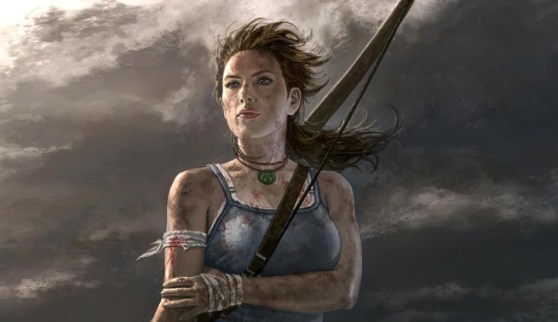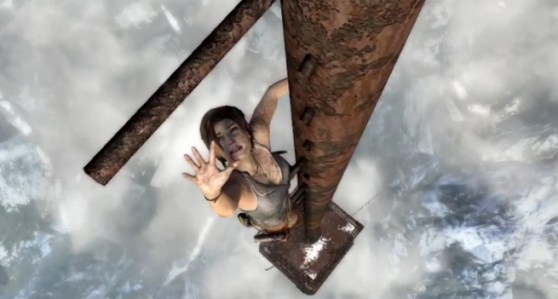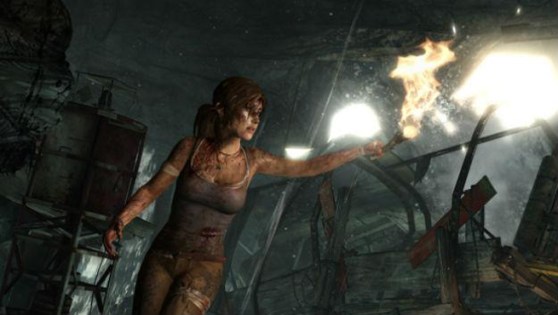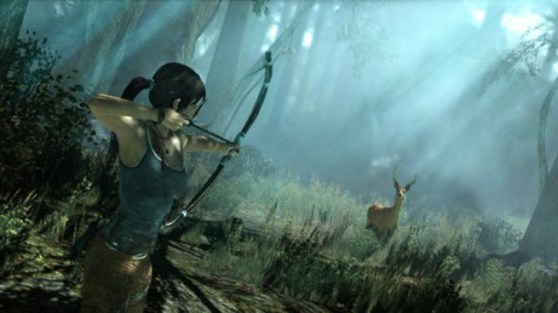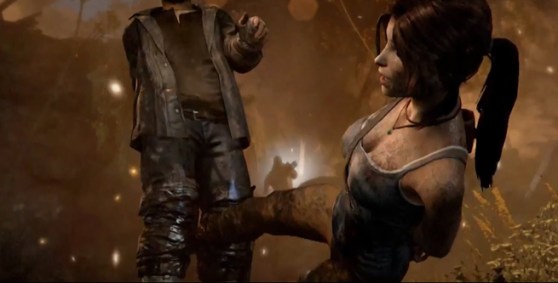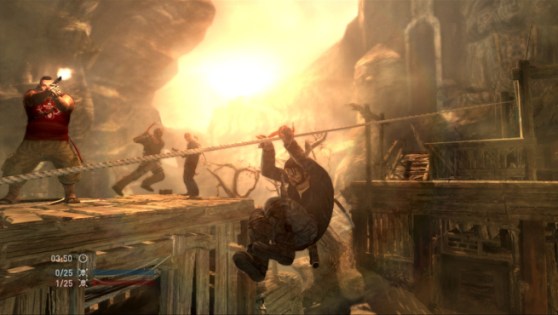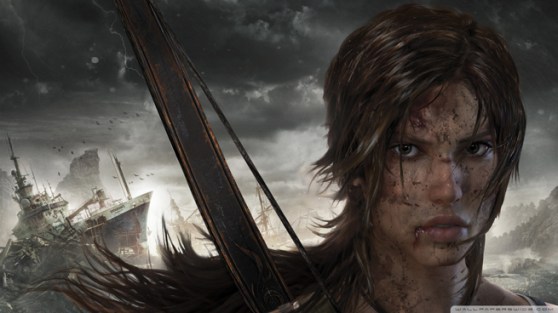Somebody must’ve recorded a thousand hours of assorted grunts, groans, gasps, screams, shrieks, whines, sighs, and labored panting for Tomb Raider, developer Crystal Dynamics’ revisionist take on the storied franchise. Iconic heroine Lara Croft throws out her first tortured moan roughly 10 seconds in and rarely stops for the next 15 hours. My wife honestly looked in on me to ask, “Are you watching porn?”
No. And it’s not torture porn, either, despite the controversy Tomb Raider (releasing March 5 for Xbox 360, PlayStation 3, and PC) generated by including threats of rape in its early demo reels. I can confirm that developer Crystal Dynamics chopped out two of the greasier moments I played last summer at the Electronic Entertainment Expo and excised any other hints of sexual assault from the rest of the game. If you still want it to offend, take heart. Regular assault is never in short supply. In the process, we see an innocent, talented, untested archeologist become Lara Croft, and the path we take to that end easily makes this Tomb Raider the grittiest, bloodiest, most brutal entry in the series’ 16-year history.
It’s also easily one of the best. Assuming you’re not too much of a traditionalist.
What you’ll like
You’re trapped on the island from Lost!
Tomb Raider’s been reimagined enough times — Crystal Dynamics first did it back in 2006 — to win a Mortal Kombat Re-Re-Retconned award, but this Lara Croft rings true. She’s fresh out of college, eager to prove herself, full of the self-doubt that comes with inexperience, and leading her first expedition to find the mythical Japanese kingdom of Yamatai. She finds it when a freak storm maroons her on the island from Lost.
I’m not kidding. A mysterious force kills anyone attempting to leave (or arrive, for that matter), and Lara’s best friend is quickly abducted by the Solarii, a hyper-violent cult not unlike the Others. And like Lost, the Solarii aren’t the island’s most dangerous inhabitants.
Those problems encourage Ms. Croft to do very dangerous things that she really doesn’t want to do, structured as linear missions in an open, beautifully designed world. The island is a fantastic mix of lush jungle and rusted-out industrialism, decorated with enough human skulls to suggest the entire Japanese army died here. Better still, unlike most action-platformers, it feels like a hostile environment where injury is commonplace — Lara gets banged up early and often — and not an obvious, video-gamey playground tailor-made for your climbing entertainment. That said, I never felt lost or coddled … not an easy balance to pull off. Visual cues benefit from smart, subtle integration, and “survivor instinct” lights up your path if you need the crutch.
Likewise, the direction impressed me simply by framing in-game shots with thought and care. Caves feel claustrophobic. Reveals have scope. Even something as mechanical as Lara climbing a ladder takes on a cinematic quality, as does Lara herself. She’s hesitant to creep past murderous cultists and climb a 200-foot radio tower in high winds, but after being hunted like an animal, suffering terrible injuries, losing friends, and killing someone for the first time, it’s such a pure, joyous moment of triumph when she actually does it.
Moments like that set this Tomb Raider apart. They made me eager to explore the island even more, and they gave me a heroine I could genuinely root for.
So a’raiding you will go!
Let’s take a random, 20-minute sampling of my playthrough: Lara got captured, escaped through a grisly mountain of body parts and viscera, discovered a new weapon, used it to gun down a horde of Solarii, evaded one of the island’s more insanely deadly natives, solved a destructive, wind-based puzzle, and then barreled through a gauntlet of shockingly frail wood buildings over a bottomless gorge as they disintegrated around her.
Oh, yeah. Tomb Raider moves.
If you loved solving the old-school puzzles … well, sorry. It doesn’t skimp on platforming and zip-lining excitement, but Tomb Raider puts the emphasis almost entirely on action. The good news is it pulls off that action very, very well. Combat feels a bit clunky at first — understandable, since Lara’s never used a weapon in anger — but a satisfying, strategic version of Uncharted’s high-pressure gunfights soon clicks into place. The stealth/cover system is nothing short of elegant. If danger’s close, Lara acts like it, hunching over so she’s de facto behind cover when you move against some. It’s also refreshing to feel pressured by an enemy A.I. that doesn’t do anything overtly stupid and constantly flushed me from cover with explosives.
Every gun in your pack comes in handy, but I fell in love with Tomb Raider’s signature weapon: Lara’s bow. It’s the first thing that gives her a sense of power, opening up the option for stealth-killing enemies at will. I cheerfully used it to clear scores of Solarii without raising the alarm, and I used it even more after amping up the arrows with fire, then napalm, then explosives.
Seriously. You won’t even miss Lara’s old dual pistols.
And you become Lara Croft!
Initially, Lara doesn’t even have a credible melee attack. By Tomb Raider’s end, she’s kneecapping giants and daring an army of ancient samurai warriors to bring it while cradling a grenade-launching assault rifle.
Her evolution happens at a steady clip, and new, exciting challenges flow from one to the next with a terrific sense of momentum. Credit also goes to an upgrade system for Lara — based on earning experience points — and her gear — bought with “salvage” collected from crates, animals, and enemies — that feels vital. Two sets of higher-tier abilities unlock once you drop enough points into scrounging Survivor, fighting Brawler, and stalking Hunter categories, making it a slow burn that accelerates nicely. I really felt the changes, and my tactics often shifted based on my new skills. Tomb Raider also regularly introduces cool, new equipment like a climbing ax and rope arrows that open new areas. Or you can just yank enemies off ledges, which never gets old.
Everything comes together when the game drops you into harrowing, breakneck sequences where Lara careens through river rapids or leaps from zipline to zipline, and a single miss equals a gruesome death. Then it stops showing you the quick-time-event prompts because you just don’t need them anymore, and that’s when I finally felt like Lara Goddamn Croft, handling the situation because that’s what we do best.
Of course, one late-game miniboss becomes borderline-impossible to defeat without the right upgrades, and a thorough player can earn every skill, making those categories redundant. And unfortunately, those aren’t Tomb Raider’s only mistakes.
What you won’t like
The timing’s off
Tomb Raider constantly builds toward its end-goal, but it peaks way too early with an exhilarating crescendo in the Solarii stronghold. Lara infiltrates, annihilates, and escapes in a pitch-perfect carnival ride … and then it’s back to more enemy-free scavenging … and more rescuing … and more traversal.
The fun doesn’t suddenly drop out, but the energy does, and Tomb Raider never really gets it back. It just keeps going for another five hours, unaware that I’ve already played a pretty amazing finale. Not even a well-earned bit of fan service can help the final confrontation measure up, and I’d argue that the finale even features the wrong villain.
Tomb Raider fires off these kinds of misstep a few times. It opens with Lara almost instantly drowning inside a ship that something’s cut in half without ever cluing you in to basics like what, who, how, where, or why. The island becomes pretty dull if you continue after finishing the campaign. You get some puzzles along the critical path, but Tomb Raider reserves most of its brain teasers — and a tease is about all you get — for optional tombs hidden around the island. Those all depends more on your reflexes than your intelligence. They also offer mandatory backtracking once you’ve completed them. On the plus side, Tomb Raider does have tombs — not a claim every game in the franchise can make.
So is the tone
The opening hours are undeniably harsh, but any sense of personal danger to Lara quickly fades as she becomes more confident, more capable, and much better armed. That’s still no excuse for letting the menace dip. And those optional tombs? Completely danger-free. Why?
Unsavory as it sounds, I wish those subtle threats of rape had stayed in the game. Far Cry 3 had them — directed at a male character — without anyone raising a fuss; I think we as an audience could’ve handled it here. Tomb Raider needed that edge of darkness to carry it through to the end, giving Lara a tangible source of fear to overcome. As-is, her transformation from terrified waif to destroyer of worlds feels subtle to the point of afterthought. We never really get a definitive moment where Lara stands up, asserts herself, and draws the line against those who threaten her. That should’ve been the centerpiece moment of this story, and it’s entirely absent.
It’s also a little glitchy (on purpose)
The code never tanks like it does in, say, Tomb Raider: Angel of Darkness or even the more recent Aliens: Colonial Marines, but you still get a fair amount of frame-rate stutters, limbs clipping through objects, cameras obscuring your view, missing items (like Lara’s bow) during a cutscene, and at least one prerendered fire that burned Lara from 3 feet away.
But the worst, most distracting glitch? That’s Lara’s signature ponytail. I’m astonished by how poorly it animates. It’s a zero-gravity, physics-defying creature someone superglued to the back of her head, and it is desperate to escape. Nitpicky? Not really. It’s ever-present in the game and the flaky star of every single cutscene. Go into the character extras and you’ll see it bouncing drunkenly on Lara’s otherwise static 3D model. The rest of Lara moves beautifully throughout the game, from her expression to her body language, so I have to believe this Medusa thing operates in exactly the way Crystal Dynamics intended. That alone completely justifies my calling it out.
And the multiplayer is disposable
Here’s what happens when you subtract the cool parts from Uncharted 3’s multiplayer and prank its button map.
Tomb Raider’s first bite at player-versus-player is inoffensive at best and pock-marked with iffy choices at worst, good for a look but not an extended stay. It does throw in a few nice touches; players spawn in unreachable bases to avoid spawn camping, and “setback” rewards give you a wee armor/damage/speed boost if you’re eating it during a match. But little imagination went into the different modes and the weapons feel unfriendly to use. It took me a while to figure out whether the assault rifles are too chattery or if frame-rate stutters sometimes make it tough to aim. Spoiler: It’s both.
Upgrading helps, but you pay separately for the different factions’ loadouts. Unlocked gear doesn’t carry over. Unlocked perks do, including “Spite,” a hysterical (if cheap) option to explode like a bomb on death. You can end up with a buffed Survivor and a baseline Scavenger, putting your hard-won advantages completely at the mercy of random chance. Or else you spread out your purchases and stay weaker across the board for longer.
Of its four modes — which also include team deathmatch, free-for-all, and supply-scrounging Rescue — Cry for Help performs best. Survivors race to secure three radio beacons before Scavengers chalk up 20 kills and collect the batteries these no-longer-Survivors drop. It’s a nice mix of control-point objectives with a bit of Call of Duty-ish “Kill Confirmed” thrown in, and it balances better than expected. At least, until poor design sabotages it. Some of those unreachable bases make nice overwatch positions across the entire map. I handily nabbed the top score by sticking to my spawn point, sniping at the opposition, and collecting my own dropped battery when they zeroed me. Big, obvious exploits like this suggests a lack of forethought and/or beta testing. Tsk.
Conclusion
Tomb Raider doesn’t screw around. It’s brutal and beautiful, anchored by a born-again Lara Croft who finally doesn’t look or act like an empty pin-up doll … or an exploitation victim, despite what you might have heard from uninformed sources. This is a lady caught up in an adventure much bigger she is, and it’s a real pleasure to experience her growing to fit it. A number of minor gaffes, an uninspired multiplayer, and a severe drop in tension defuse Tomb Raider somewhat, but nothing stops it from living up to Lara’s legacy.
I’m ready for the encore.
Score: 88/100
Tomb Raider releases March 5 for PC, Xbox 360, and PlayStation 3. The publisher provided GamesBeat with a retail Xbox 360 copy of the game for the purposes of this review.
VentureBeat's mission is to be a digital town square for technical decision-makers to gain knowledge about transformative enterprise technology and transact. Learn More
